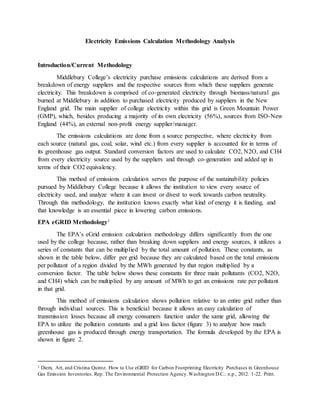
EPA Egrid vs Middlebury Energy Calculations
- 1. Electricity Emissions Calculation Methodology Analysis Introduction/Current Methodology Middlebury College’s electricity purchase emissions calculations are derived from a breakdown of energy suppliers and the respective sources from which these suppliers generate electricity. This breakdown is comprised of co-generated electricity through biomass/natural gas burned at Middlebury in addition to purchased electricity produced by suppliers in the New England grid. The main supplier of college electricity within this grid is Green Mountain Power (GMP), which, besides producing a majority of its own electricity (56%), sources from ISO-New England (44%), an external non-profit energy supplier/manager. The emissions calculations are done from a source perspective, where electricity from each source (natural gas, coal, solar, wind etc.) from every supplier is accounted for in terms of its greenhouse gas output. Standard conversion factors are used to calculate CO2, N2O, and CH4 from every electricity source used by the suppliers and through co-generation and added up in terms of their CO2 equivalency. This method of emissions calculation serves the purpose of the sustainability policies pursued by Middlebury College because it allows the institution to view every source of electricity used, and analyze where it can invest or divest to work towards carbon neutrality. Through this methodology, the institution knows exactly what kind of energy it is funding, and that knowledge is an essential piece in lowering carbon emissions. EPA eGRID Methodology1 The EPA’s eGrid emission calculation methodology differs significantly from the one used by the college because, rather than breaking down suppliers and energy sources, it utilizes a series of constants that can be multiplied by the total amount of pollution. These constants, as shown in the table below, differ per grid because they are calculated based on the total emissions per pollutant of a region divided by the MWh generated by that region multiplied by a conversion factor. The table below shows these constants for three main pollutants (CO2, N2O, and CH4) which can be multiplied by any amount of MWh to get an emissions rate per pollutant in that grid. This method of emissions calculation shows pollution relative to an entire grid rather than through individual sources. This is beneficial because it allows an easy calculation of transmission losses because all energy consumers function under the same grid, allowing the EPA to utilize the pollution constants and a grid loss factor (figure 3) to analyze how much greenhouse gas is produced through energy transportation. The formula developed by the EPA is shown in figure 2. 1 Diem, Art, and Cristina Quiroz. How to Use eGRID for Carbon Footprinting Electricity Purchases in Greenhouse Gas Emission Inventories. Rep. The Environmental Protection Agency.Washington D.C.: n.p., 2012. 1-22. Print.
- 2. Table 1: eGrid total emissions output rate for CO2, CH4, and N2O. The red box displays the New England NPCC’s emissions rates utilizes by Middlebury College. Figure 1: Line loss emission rate formula developed by the EPA to calculate greenhouse gas emission rates for each grid. ERg is displayed in the table above and FFL is displayed in the figure below.
- 3. Conclusion Our current methodology aligns with the goals of the carbon neutrality policy because it allows us to analyze individual sources of energy along with their suppliers, allowing the college to choose energy options based on environmental consciousness. Despite this, the EPA’s methodology provides an avenue to estimate emissions through transmission losses, a factor that Middlebury does not take into consideration. To account for this, the institution should utilize the eGrid formula to estimate transmission losses while preserving the energy purchase source analysis in order to create the most comprehensive emissions data. It should be noted that the EPA calculations account for all sources of electricity within a grid, including non-renewable ones, causing emission calculations to be much higher than reality for an institution like Middlebury, which is incredibly environmentally selective in its energy source portfolio. Utilizing eGrid calculations would give the grid standard emission rates for the electricity produced at Middlebury without taking the institution’s substantial renewable energy utilization into account, generating emission rates that are higher than actuality. Figure 2: eGrid loss factors utilized to calculate grid loss rate through the formula above. The red box displays the grid Middlebury utilizes.